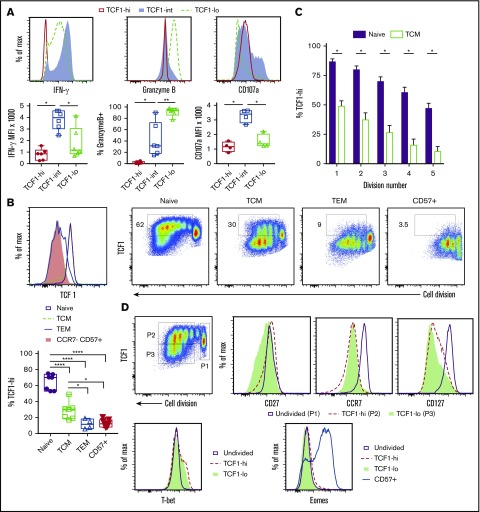Figure 2.
Self-renewal of TCF1-hi CD8+T cells. Distinct functional properties of TCF1 subsets. (A) Peripheral blood mononuclear cells stimulated with 12-O-tetradecanoylphorbol 13-acetate/ionomycin and analyzed for cytokine (IFN-γ) and cytolytic molecule (granzyme B) expression and degranulation (CD107a). *P < .05; **P < .01 (repeated-measures 1-way ANOVA with Sidak correction). (B) TCF1-hi cells self-renew following T-cell receptor (TCR) stimulation. The histogram on the left shows steady-state TCF1 expression by FACS-sorted CCR7+CD45RA+CD57− (naive), CCR7+CD45RA−CD57− (TCM), CCR7−CD45RA−CD57− (TEM), and CCR7−CD57+ populations. Data are representative of 5 separate donors. FACS-sorted naive, TCM, TEM, and CCR7−CD57+CD8+ T cells were TCR stimulated (right). Cell division vs TCF1 expression at day 4 is shown. Gate denotes TCF1-hi population. Quantification of TCF1-hi population frequency (bottom left). *P < .05; ****P < .0001 (1-way ANOVA with the Sidak multiple comparisons test). (C) Earlier loss of TCF1-hi cells from TCM following activation. Naive and TCM populations were sorted and stimulated as in panel B. Frequency of TCF1-hi cells was quantified on day 4 for naive and TCM starting populations at each division number. *P < .05 (Student t test with Holm-Sidak correction for multiple comparisons). (D) Stepwise differentiation of TCF1-hi and TCF1-lo populations following activation of naive CD8+ T cells. Gating of undivided (P1), TCF1-hi (P2), and TCF1-lo (P3) populations at day 4 of culture following TCR stimulation of naive cells (top left). The remaining panels show representative histograms of CD27, CCR7, CD127, T-bet, and Eomes expression by each population. Activated CD57+ cells were included as a positive control for Eomes induction. Plots are representative of 3 independent donors.

